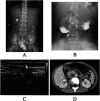Duodenal obstruction due to two congenital bands: a case report and literature review
- PMID: 39896722
- PMCID: PMC11784611
- DOI: 10.3389/fped.2025.1491520
Duodenal obstruction due to two congenital bands: a case report and literature review
Abstract
Introduction: Anomalous congenital bands are a rare cause of intestinal obstruction, with only five previously reported cases involving duodenal obstruction. We present a fifth case of duodenal obstruction due to two congenital bands and provide a comprehensive literature review summarizing the clinical features of this condition.
Case report: An eight-year-old girl was admitted to our department with recurrent bilious vomiting and abdominal pain lasting six days. She had no significant past medical history, with no previous abdominal surgeries or trauma. Physical examination revealed abdominal tenderness and decreased bowel sounds. Contrast x-ray showed an obstructed passage of contrast through the third part of the duodenum. Abdominal ultrasound identified a strip-like hypoechoic structure compressing the third part of the duodenum. A diagnosis of duodenal obstruction was confirmed, and laparoscopic surgery combined with gastroduodenoscopy was performed. The procedure revealed two congenital bands adjacent to the duodenum: one extending from the duodenum to the transverse colon, and the other from the duodenum to the root of the mesentery. The bands were resected, and gastroduodenoscopy confirmed the resolution of the obstruction.
Discussion: We reviewed 93 cases of anomalous congenital bands, including the present one, comprising 33 adults and 60 children, with 71.0% of the cases involving males. Common symptoms included vomiting and abdominal pain, with physical examinations often showing tenderness and distension. Imaging techniques like plain x-ray, contrast x-ray, ultrasound, and computed tomography often indicated intestinal obstruction but were less effective in directly identifying congenital bands. All cases required abdominal surgery for diagnosis and treatment. Congenital bands were primarily found attached to the ileum or its mesentery and were resected in all cases, with a favorable postoperative prognosis. This case and the literature review provide valuable insights for clinical diagnosis and treatment.
Keywords: anomalous congenital band; case report; clinical features; intestinal obstruction; literature review.
© 2025 Xiong, Ge, Hou, Yang, Zhang, Zhang, Liu, Hao, Fang and Ren.
Conflict of interest statement
The authors declare that the research was conducted in the absence of any commercial or financial relationships that could be construed as a potential conflict of interest.
Figures



Similar articles
-
[Congenital anomaly band, a rare cause of intestinal obstruction in children. Case report].Cir Cir. 2017 Mar-Apr;85(2):164-167. doi: 10.1016/j.circir.2015.10.011. Epub 2016 Jan 6. Cir Cir. 2017. PMID: 26769532 Spanish.
-
Congenital duodenal web causing partial obstruction with recurrent vomiting and abdominal distention in a toddler boy: a case report.J Med Case Rep. 2023 Nov 24;17(1):507. doi: 10.1186/s13256-023-04179-3. J Med Case Rep. 2023. PMID: 37996900 Free PMC article.
-
A case report of small bowel obstruction secondary to congenital peritoneal band in adult.Int J Surg Case Rep. 2017;30:23-25. doi: 10.1016/j.ijscr.2016.11.007. Epub 2016 Nov 18. Int J Surg Case Rep. 2017. PMID: 27898351 Free PMC article.
-
Obstructive internal hernia caused by mesodiverticular bands in children: Two case reports and a review of the literature.Medicine (Baltimore). 2017 Nov;96(46):e8313. doi: 10.1097/MD.0000000000008313. Medicine (Baltimore). 2017. PMID: 29145243 Free PMC article. Review.
-
Intestinal obstruction due to congenital bands in adults who have never had abdominal surgery Two case reports and a review of the literature.Ann Ital Chir. 2019;90:524-531. Ann Ital Chir. 2019. PMID: 31929177 Review.
Cited by
-
Large bowel obstruction in an adolescent caused by dolichocolon and a fibrotic band of Toldt: A rare case report.Int J Surg Case Rep. 2025 Sep;134:111702. doi: 10.1016/j.ijscr.2025.111702. Epub 2025 Jul 18. Int J Surg Case Rep. 2025. PMID: 40694929 Free PMC article.
References
Publication types
LinkOut - more resources
Full Text Sources
Miscellaneous

